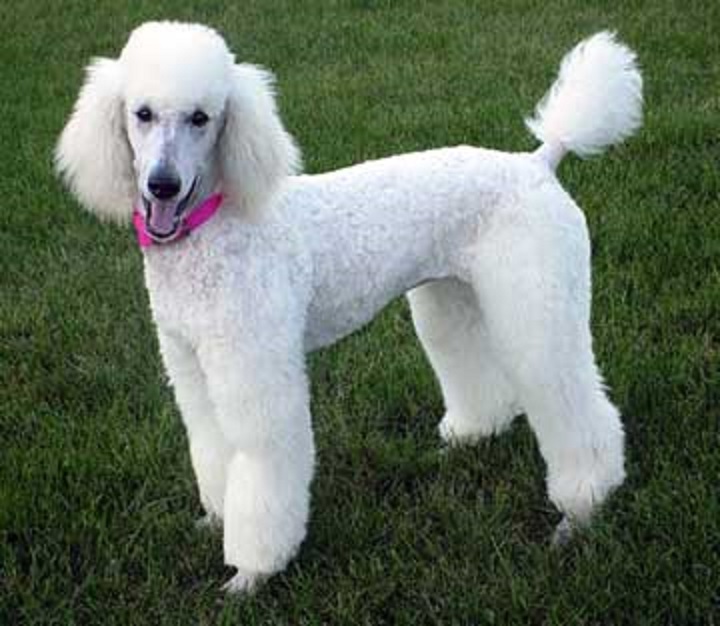
Poodle

Navigate through the tabs
Navigate through the tabs below to view the breed's info of your interest.
The breed's info is divided in four sections; namely:
the breed's history ,
the breed's main stats ,
the dog's potential health issues
and finally, how the breed scored in 26 different categories.
All the above information should give you a respectively good overview for the dog of your interest.
Dog Breed's Main Info
The Breed's History:
The Poodle is one of the oldest breeds developed especially for hunting waterfowl. Most historians agree that the Poodle originated in Germany, but developed into his own distinct breed in France.
Many believe that the breed is the result of crosses between several European water dogs, including Spanish, Portuguese, French, German, Hungarian, and Russian water dogs.
Other historians think that one of the Poodle's ancestors is the North African Barbet, which was imported to the Iberian Peninsula. After that, the breed arrived in Gaul where it was used for his hunting abilities.
It's also commonly believed that Poodles descended from Asian herding dogs, and then traveled with the Germanic Goth and Ostrogoth tribes to eventually become a German water dog.
Yet another theory is that the Poodle descended from dogs that were brought out of the Asian steppes by the conquering North African Berbers and eventually found his way into Portugal in the 8th Century with the Moors.
Whatever its ancestry, this is a very old breed. Illustrations of Poodle-like dogs adorn Egyptian and Roman artifacts and tombs dating from the first centuries B.C.
The drawings and statues show dogs that look very much like modern-day Poodles, bringing in game nets, herding animals, and retrieving game from marshes.
Although some say that the Miniature and Toy Poodles emerged shortly after the Standard, many believe it wasn't until the 1400s that breeders began producing smaller versions of the Poodle - first the Miniature, then the Toy - to delight the Parisian bourgeoise.
The Toy and Miniature varieties were created by breeding small Poodles to each other, not by breeding Poodles to smaller breeds.
The French used the larger Standard Poodle for duck hunting, and the mid-sized Miniature Poodle to sniff out truffles in the woods. The tiny Toy Poodle's main job, on the other hand, was to serve as a companion to the nobility and wealthy merchant class.
Well-to-do owners in the Renaissance often carried their Toy Poodles in their large shirtsleeves, leading to the nickname "sleeve dogs".
Gypsies and traveling performers learned that Poodles excelled in another canine profession: circus dog. They trained Poodles to perform tricks, dressing them in costumes and sculpting their coats into fanciful shapes to add to their stage appeal.
Wealthy patrons took note and started clipping, decorating, and even dying their own Poodle companions.
The Kennel Club in England registered their first Poodle in 1874, with the first British club for Poodle fanciers arriving on the scene two years later. It's not known for sure when Poodles arrived in the U.S., but the American Kennel Club registered their first Poodle in 1886.
The Poodle Club of America was founded in 1896, but disbanded shortly thereafter. Poodle enthusiasts reestablished the club in 1931.
Poodles were fairly rare in the U.S. until after World War II. By the mid-1950s, however, the Poodle had become the most popular breed in the country, a position he held for more than 20 years.
Country of Origin:
Germany / France
Breed Group:
Companion
Height:
1 foot, 10 inches (55,88 cm)
Weight:
45 to 70 pounds (20,41 to 31,76 Kg)
Life Span:
12 to 15 years
Potential Health Issues:
Gastric Dilatation-Volvulus,
Hip Dysplasia,
Addison's Disease,
Cushings Disease (Hyperadrenocorticism),
Hypothyroidism,
Epilepsy,
Legg-Perthes Disease,
Progressive Retinal Atrophy (PRA),
Optic Nerve Hypoplasia,
Sebaceous Adenitis (SA),
Von Willebrand's Disease,
Patellar Luxation
Adaptability
Apartment Living:
First Time Owners:
Sensitivity:
Being Alone:
Cold Weather:
Hot Weather:
Friendliness
Affection With Family:
With Kids:
With Dogs:
With Strangers:
Health and Grooming
Shedding:
Drooling:
Easy To Groom:
Overall Health:
Weight Gain Potential:
Size:
Training
Easiness:
Intelligence:
Mouthiness:
Prey Drive:
Barking or Howling:
Wanderlust:
Need For Exercise
Energy Level:
Intensity:
Exercise Needs:
Playfulness:
Our Mobile Application
Check out Our Mobile Application "Dog Breeds Central"
